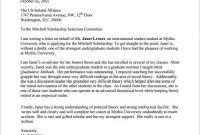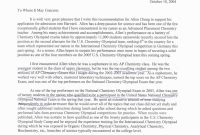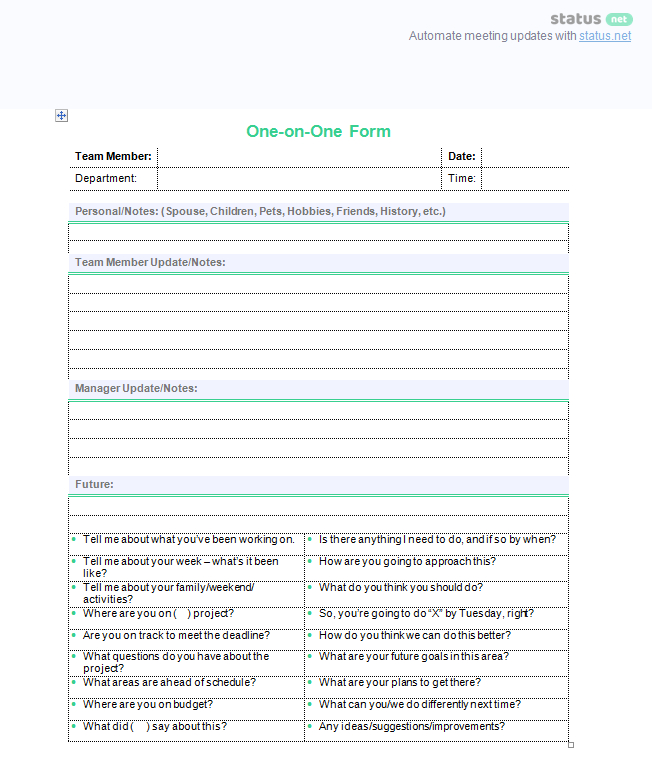 Employee One On One Template Debandje intended for proportions 652 X 782
Employee One On One Template Debandje intended for proportions 652 X 782
One On One Meeting Template Excel – One-on-one meetings are essential for effective communication, employee development, and performance tracking. Utilizing an Excel template for one-on-one meetings can significantly streamline the process, ensuring consistency and efficiency. This comprehensive guide aims to assist managers, team leaders, supervisors, and HR professionals in mastering one-on-one meetings using an Excel template. By the end of this article, you will be well-equipped to create, customize, and implement a one-on-one meeting template in Excel, leading to improved performance and enhanced communication within your team.
Preparing the One-On-One Meeting Template
Essential components to include:
Employee information: Begin by creating a section for employee details, such as name, job title, department, and hire date. This information will help you keep track of each employee’s progress and performance.
- Meeting schedule: Establish a consistent meeting schedule, including the frequency and duration of one-on-one meetings. This will help you dedicate adequate time to each team member and maintain a balanced workload.
- Agenda items: Create a space for agenda items, allowing you and the employee to list discussion points beforehand. This will facilitate focused and productive conversations during the meetings.
- Goals and performance tracking: Include sections for short-term and long-term goals and key performance indicators (KPIs). This will enable you to track progress, provide feedback, and adjust expectations.
- Meeting outcomes and action items: Include an area for recording meeting outcomes, action items, and follow-up tasks. This will help hold both you and the employee accountable for agreed-upon objectives.
Customizing the template for your needs:
- Adapting columns and rows: Customize the layout by adding or removing columns and rows to suit your requirements. This may include incorporating additional employee details or performance metrics.
- Formatting and conditional formatting: Use Excel’s formatting options to enhance your template’s visual appeal and functionality. Conditional formatting can be handy for highlighting important information or flagging areas of concern.
- Incorporating company branding: Customize your template with company brandings, such as logos, colors, and fonts. This will ensure consistency and professionalism across all company documents.
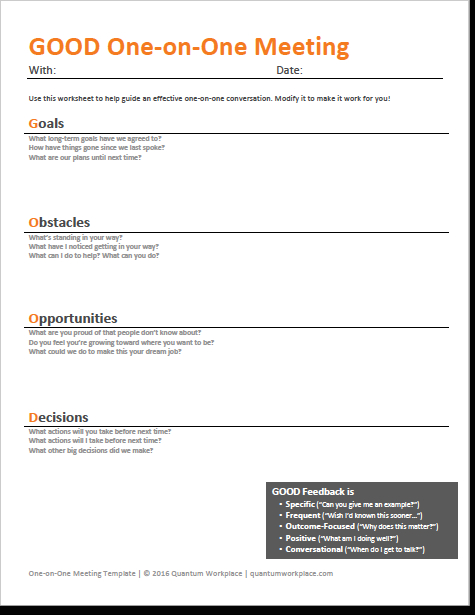
Scheduling and Planning One-On-One Meetings
Setting up regular meetings:
- Frequency and duration: Determine the frequency and duration of one-on-one meetings based on your team’s size, goals, and needs. Regular meetings foster open communication and enable ongoing performance tracking.
- Time-saving strategies: Utilize calendar tools and scheduling software to streamline the process of scheduling one-on-one meetings. This will help save time and reduce administrative workload.
Allocating time for each employee:
- Balancing priorities and schedules: Allocate sufficient time for each employee, balancing priorities, plans, and workload. This will ensure consistency and fairness in the attention given to each team member.
- Ensuring consistency and fairness: Regularly review and adjust your schedule to accommodate changes in priorities and employee needs. This will promote a culture of fairness and equal opportunity for growth and development.
Pre-meeting preparation and agenda:
- Gathering input from employees: Encourage employees to contribute to the agenda by submitting discussion points and concerns beforehand. This will promote open communication and enable more focused meetings.
- Identifying key discussion points: Prioritize the most critical discussion points, addressing employee concerns, performance updates, and goal-setting.
Conducting Effective One-On-One Meetings
Open communication:
- Building rapport and trust: Establish a positive atmosphere by fostering connection and trust with employees. This will encourage open and honest communication, leading to more effective meetings.
- Encouraging feedback and ideas: Actively solicit employee feedback and ideas during one-on-one meetings. This will help you identify areas for improvement and opportunities for innovation and growth.
Goal setting and performance tracking:
- Collaboratively defining objectives: Work with employees to set short-term and long-term goals, ensuring they align with company objectives and individual strengths.
- Monitoring progress over time: Use the Excel template to track goal progress and performance metrics, provide regular feedback, and adjust expectations as needed.
Addressing employee concerns:
- Active listening and empathy: Demonstrate active listening and empathy during meetings, acknowledging employee concerns and validating their feelings.
- Providing support and resources: Offer support to help employees overcome challenges and improve performance, including training, mentorship, or workload adjustments.
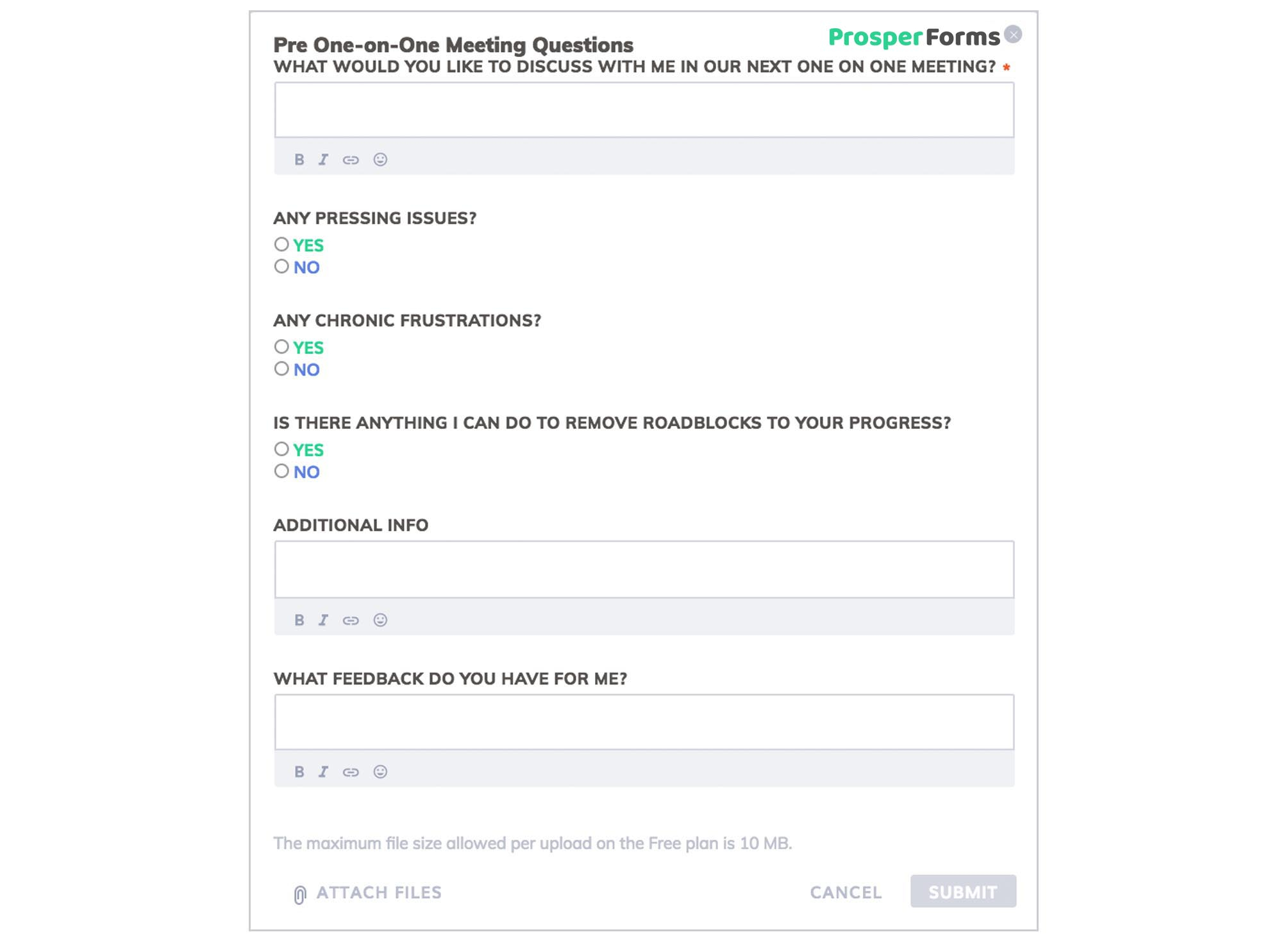 One On One Meeting Template Excel Debandje regarding measurements 2009 X 1479
One On One Meeting Template Excel Debandje regarding measurements 2009 X 1479Post-Meeting Follow-Up
Recording key points and action items:
- Updating the Excel template: Record meeting outcomes, action items, and follow-up tasks in the Excel template, ensuring both you and the employee have a clear understanding of the agreed-upon objectives.
- Assigning responsibilities and deadlines: Clearly outline responsibilities and deadlines for each action item, promoting accountability and efficient execution.
Monitoring progress and updates:
- Regular check-ins between meetings: Conduct regular check-ins between one-on-one meetings to monitor progress, provide support, and address emerging concerns.
- Adjusting goals and expectations as needed: Update goals and expectations as needed based on employee performance, company objectives, and changing circumstances.
Analyzing and Improving Meeting Outcomes
Identifying trends and patterns:
- Using Excel functions and data visualization: Leverage Excel’s powerful functions and data visualization tools to analyze trends and patterns in employee performance and meeting outcomes.
- Recognizing areas for improvement: Identify areas where improvements can be made, such as communication, goal-setting, or resource allocation.
Making data-driven decisions:
- Evaluating employee performance: Use the data gathered in the Excel template to evaluate employee performance, making informed decisions about promotions, raises, and professional development opportunities.
- Guiding team development and growth: Utilize the insights gained from your analysis to drive team development and growth, fostering a culture of continuous improvement and high performance.
Continuously refining the process:
- Adapting the template based on feedback: Gather feedback from employees and stakeholders to continually refine and improve the Excel template and one-on-one meeting process.
- Implementing best practices: Stay informed of best practices in one-on-one meetings and employee management, incorporating new ideas and approaches into your template and process.
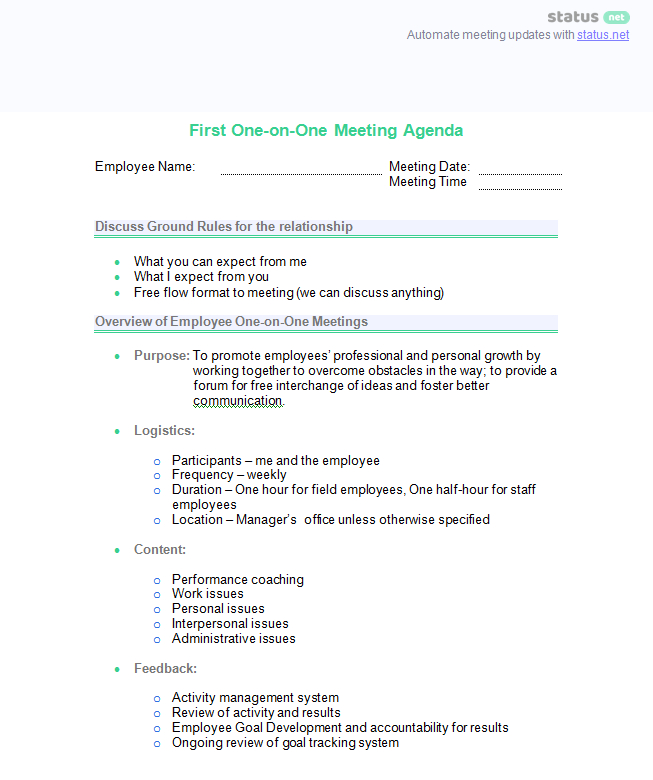 Employee One On One Template Debandje about sizing 653 X 780
Employee One On One Template Debandje about sizing 653 X 780
Tips for Maximizing the Benefits of the Excel Template
Leveraging Excel features and tools:
- Data validation: Implement rules to ensure accurate and consistent data entry in your template.
- Conditional formatting: Use conditional formatting to highlight important information, such as missed deadlines or performance concerns.
- Charts and graphs: Create charts and graphs to visualize trends and patterns in employee performance, making data-driven decisions more accessible.
Integrating the template with other systems:
- Calendars and scheduling tools: Integrate the Excel template with calendar and scheduling tools to streamline the scheduling and planning process.
- Project management software: Connect the template with project management software to track progress on action items and ensure alignment with broader project objectives.
- HR systems: Link the Excel template to HR systems to ensure seamless data flow and accurate record-keeping.
Sharing and collaborating with team members:
- File sharing and version control: Use file-sharing platforms and version control systems to collaborate with team members and stakeholders on the Excel template.
- Protecting sensitive information: Implement security measures, such as password protection and restricted access, to protect sensitive employee information.
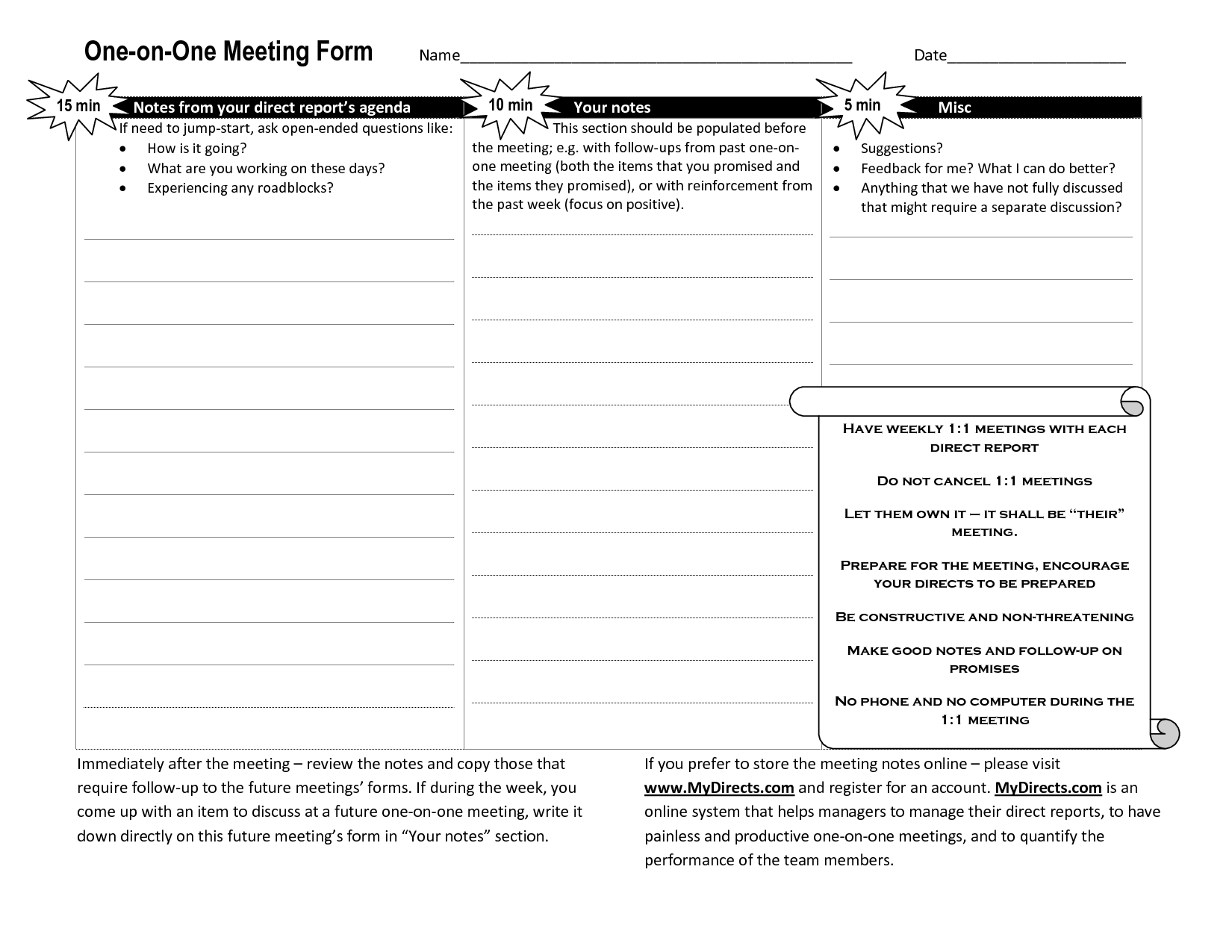 One On One Meeting Template Excel Debandje within dimensions 1650 X 1275
One On One Meeting Template Excel Debandje within dimensions 1650 X 1275Conclusion
In summary, leveraging an Excel template for one-on-one meetings can significantly enhance communication, employee performance, and overall team success. This comprehensive guide has provided the tools and insights to create, customize, and implement an effective one-on-one meeting template in Excel. By following the strategies and best practices outlined in this article, you can streamline the process of scheduling, planning, and conducting one-on-one meetings, leading to improved performance and enhanced communication within your team.
As you move forward, continue to refine your Excel template and meeting process based on feedback from employees and stakeholders, ensuring your approach remains up-to-date and relevant. Embrace the power of Excel’s features and tools to analyze and improve meeting outcomes, fostering a data-driven approach to employee management and team development.
By mastering the art of one-on-one meetings using an Excel template, you can foster a culture of open communication, continuous improvement, and high performance. This will ultimately contribute to the success of your team and organization. So, start implementing your customized Excel template for one-on-one meetings today and witness the transformative impact on your team’s performance and morale.
As you continue to explore practical strategies for managing your team, we invite you to dive deeper into our “Business Template” category on howtostepmom.com. With a wealth of resources designed to optimize your day-to-day operations, our expertly crafted articles cover various topics, from project management templates to financial planning tools. Whether you’re a seasoned leader or just stepping into a supervisory role, our comprehensive guides will empower you to navigate the business world quickly and confidently. Visit howtostepmom.com today and unlock your full potential with our carefully curated “Business Template” resources.
